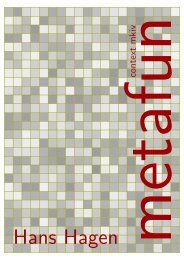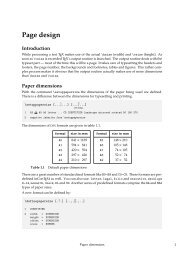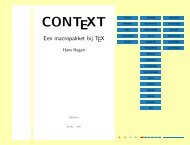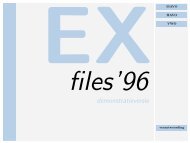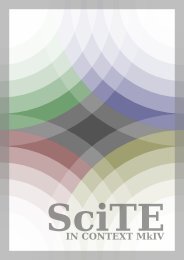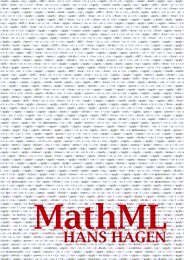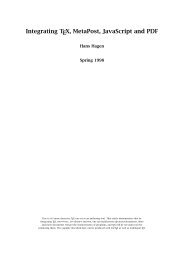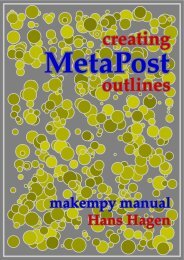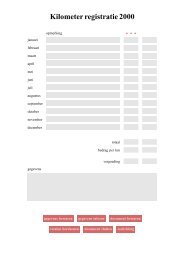Hagen - Pragma ADE
Hagen - Pragma ADE
Hagen - Pragma ADE
You also want an ePaper? Increase the reach of your titles
YUMPU automatically turns print PDFs into web optimized ePapers that Google loves.
Comment TFM fontdimen 19: 0.22223 (non-standard: overshoot)<br />
Comment TFM fontdimen 20: 0.25 (non-standard: thin stem, hair)<br />
Comment TFM fontdimen 21: 0.30556 (non-standard: cap thin stem, i.e., cap_hair)<br />
Comment TFM headerbyte 9: FontSpecific<br />
Comment TFM headerbyte 49: LMRoman10<br />
Comment TFM headerbyte 72: 234<br />
Watch the comments! Because T E X needs a couple of so called fontdimens to be set,<br />
the comments list the appropriate values. When a tfm file is generated from an afm file,<br />
these values have to be used.<br />
Each character (or glyph) gets an entry. When we run out of indices i.e. pass the 255<br />
boundary (we start at 0) the index becomes -1. Only the width is specified. The height<br />
and depth have to be derived from the bounding box for which the specification starts<br />
with key B.<br />
StartCharMetrics 821<br />
...<br />
C 32 ; WX 333.33333 ; N space ; B 0 0 0 0 ;<br />
...<br />
C 102 ; WX 305.55556 ; N f ; B 33 0 357 705 ; L f ff ; L i fi ; L k f_k ; L l fl ;<br />
C 105 ; WX 277.77777 ; N i ; B 33 0 247 657 ;<br />
C 108 ; WX 277.77777 ; N l ; B 33 0 255 694 ;<br />
...<br />
C -1 ; WX 500 ; N Acute ; B 181 493 388 656 ;<br />
C -1 ; WX 500 ; N acute ; B 188 510 374 698 ;<br />
C -1 ; WX 500 ; N acute.ts1 ; B 208 513 392 699 ;<br />
...<br />
EndCharMetrics<br />
Watch how this font defines a space character and keep in mind that these fonts date<br />
from the time that there was only one kind of space. The L entry specifies a ligature.<br />
The names of glyphs are standardized, and even the f_k is conforming to standards.<br />
This standardization makes it possible to go back from glyphs to characters when copying<br />
text from a typeset document.<br />
The kern table is pretty large here and for a reason. First of all the file defines 821<br />
glyphs so the average amount of kerns per glyph is not that large. But take a look at the A.<br />
Because the Aacute has the same shape it kerns in a similar way. This means that ideally<br />
all combined characters end up with the same value as their base glyph. However, in<br />
our case a bit more selective approach is taken. The Adieresis has a different set of<br />
kerns, probably to save space. It is for this reason that OpenType fonts have a model of<br />
kern classes so that similar shapes can be treated as one when setting kerns. You see a<br />
similar issue with ligatures, where often the right part of the shape kerns the same as<br />
the (stand alone) first part of the shape does.<br />
StartKernData<br />
StartKernPairs 9230<br />
153<br />
Appendix



